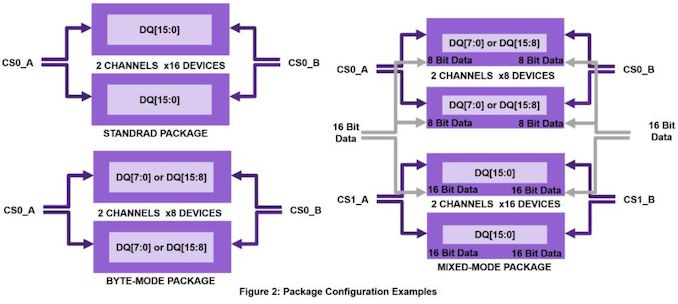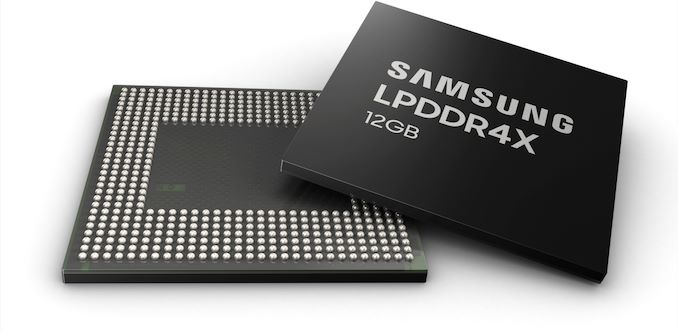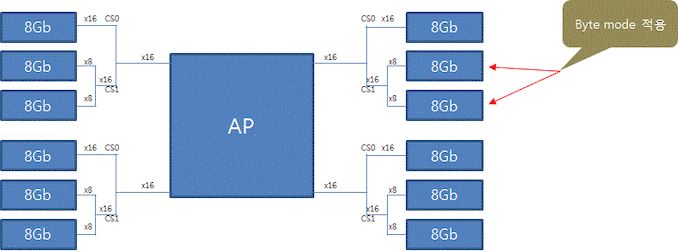Samsung Begins Mass Production of 12 GB LPDDR4X for Smartphones
by Anton Shilov on March 14, 2019 4:00 PM EST- Posted in
- Memory
- Samsung
- Smartphones
- 10nm
- LPDDR4X

Samsung announced late on Wednesday that it had started volume production of 12 GB LPDDR4X-4266 memory for high-end smartphones. The chip is currently the highest-density DRAM for mobile applications. The first smartphone to use Samsung’s 12 GB LPDDR4X DRAM package will be the company’s own Galaxy S10+ handset formally announced last month.
Samsung’s 12 GB LPDDR4X package integrates six 16 Gb memory devices featuring a 4266 MT/s data transfer rate at 1.1 Volts and produced using the company’s second-generation '10nm-class' process technology (also known as 1y-nm). The 12 GB memory module is 1.1 mm tall, which is a bit higher than standard quad-die LPDDR4X packages (which are thinner than 1 mm), but Samsung has managed to incorporate the device into its latest premium smartphone.
Samsung’s 16 Gb LPDDR4X devices have been in mass production for well over half a year now, so it was a matter of time before Samsung assembled a 12 GB package for smartphones using these chips. However, integrating six 16 Gb LPDDR4X memory devices into a single package was not a straitforward task.
Standard LPDDR4/LPDDR4X modules use one, two, or four memory devices (for simplicity, we are going to use terminology from Synopsys here). Single-die and dual-die “Standard Packages” contain one or two x32 DRAM devices featuring two independent x16 data buses per die. There are also “Byte-Mode Packages” because they use dies connected using two x8 data buses to the host memory controller. Finally, there are “Mixed Mode Packages” that contain DRAM devices that are accessed differently in different ranks.
 Image source: Synopsys
Image source: Synopsys
Samsung’s 12 GB LPDDR4X package is among the industry’s first LPDDR4X MMP products that provides a peak memory bandwidth of up to 34.1 GB/s. The package uses a dual-rank topology along with x8 and x16 data buses. Samsung calls this "mixed" byte and non-byte mode.
Traditionally, DRAM makers announce start of mass production after they ship the first batch of devices to a customer. Keeping in mind that Samsung introduced its Galaxy S10+ last month and the phone is about to hit volume production, it is not surprising that the company’s 12 GB LPDDR4X packages have already been supplied. It is noteworthy that Samsung promises to boost production of 8 GB and 12 GB LPDDR4X packages in the second half of the year to meet “the anticipated high demand”.
Related Reading
- Samsung Starts Production of 16 Gb LPDDR4X Chips Using 2nd Gen 10nm Tech
- Samsung Announces The Galaxy S10: 10th Anniversary Trio
- Samsung Introduces 8 GB LPDDR4-4266 Package for Mobile Devices
- Micron Kicks Off Mass Production of 12 Gb LPDDR4X DRAM Chips
- SK Hynix Announces 8 GB LPDDR4X-4266 DRAM Packages
Source: Samsung












19 Comments
View All Comments
Exodite - Thursday, March 14, 2019 - link
Jeez, I can't decide if I'm just old or confused.I realize modern media takes up a lot of space but my 2003 desktop was clearly overprovisioned with 16MB, and still runs fine, so I can't help questioning why a modern phone (or desktop for that matter) can swallow three orders of magnitude more memory.
Excuse me while I go push some youngsters off my lawn. :P
surt - Thursday, March 14, 2019 - link
It's mostly going to 3d rendering. Your desktop's desktop is rendered in 2d, this phone's desktop is 3d. Same thing for basically all interesting applications.willis936 - Friday, March 15, 2019 - link
Does it need to be? More importantly if 12 GB offers benefit to the OS then how did phones scrape by with less than 1 GB of RAM using the same OSes?Jorgp2 - Thursday, March 14, 2019 - link
Maybe to keep more things in memory and reduce disk transfers?boeush - Thursday, March 14, 2019 - link
It's partly because much of the modern software development consists of stacking abstraction layers on top of other abstraction layers.So that you end up with an application sandbox running on top of the OS, with a Java VM running on top of the sandbox, with an app running on top of the VM, with a web view running on top of the app, with JavaScript VM running on top of the web view, with JavaScript code running on top of the JavaScript VM... And wasteful memory use as well as caching at all the various levels, while we're at it. And multiple such apps running concurrently. Plus all the other OS services, cached filesystem and network transfers, cached assets (such as for 3D rendering, etc.), and so on.
tl;dr modern software developers are experts at spending whatever compute resources you can throw at them, and are always asking for more.
HollyDOL - Friday, March 15, 2019 - link
Well, the problem is everyone wants the apps in "yesterday was late" fashion. Add in there are not enough developers worldwide to satisfy the demand even when things are hugely done with prefabricated components.Data requirements skyrocketed as well, computers are now processing significantly more than they used to (practical example... when I started coding, your usual gaming resolution was 320x200... and high end games were at 256 colours... that gives you 64kB memory if uncompressed... today let's say usual is 1920x1080 at 32bit colours... giving you ~8294kB memory uncompressed... roughly 130 times rise), follow with audio and you can go on and on.
And we are not even touching topics like security comparing some small-studio-baked solution to proven publicly available library...
deil - Friday, March 15, 2019 - link
If you look at minimal linux with 1920 resolution, it works with 512 ram.above that is all cache & graphical effects, concurency of programs that load 50 MB each at least to correctly talk to GPU driver. Throw animations and HD icons into mix and it goes up rapidly.
check number of threads you have, (propably 1000+, each needs a bit of ram for itself).
on windows its even worse, all about windows on windows and loading shitabyte of data to keep backward compatibility with every single bug they had since 98.
They also exec multiple things without your knowing (and hidden from task manager), which will steal another piece, and so on.
HollyDOL - Friday, March 15, 2019 - link
... and we are still barely scratching surface :-)prophet001 - Friday, March 15, 2019 - link
This is so true.Soooo much bloat in today's software.
cpkennit83 - Friday, March 15, 2019 - link
Desktops had 16mb ram by 1997. No desktop assembled in 2003 had anything less than 512mb. Win XP would die with 16mb